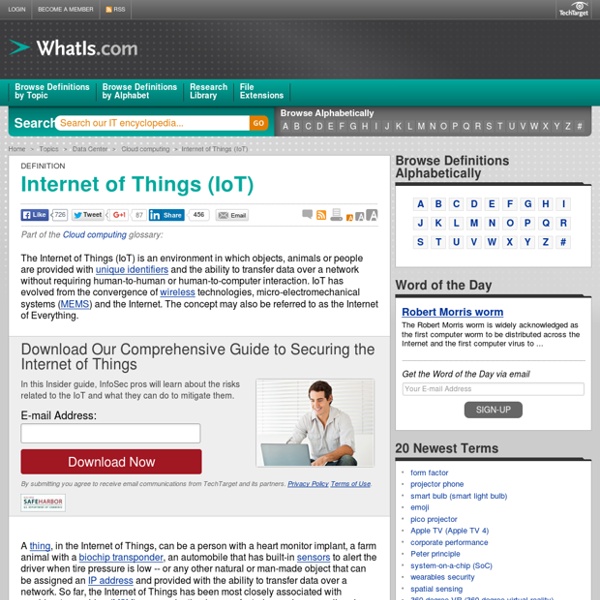iot-report.pdf
AR Champion – Applications Android sur Google Play
AR Champion is an Augmented Reality application showcasing 3D model of Champions in League of Legends.This application does not display any advertisement or track its users.The 10 Champion models included in the app are: Amumu, Annie, Heimerdinger, Kennen, Lulu, Poppy, Rammus, Teemo, Tristana and Ziggs.To use the app, you need to download the marker image file from: bigger the marker used, the bigger the Champion model.You can print and use anywhere you want.The application allow you to rotate, zoom in & out, move the model, as well as capturing a screenshot.
The Pros and Cons of the Internet of Things
Image a time when you are grocery shopping and your home computers contact you to let you know that your milk is about to expire, your yogurt has expired, you are about to run out of sugar, and you are completely out of your favorite juice. This is not science fiction. This is just one example of the capabilities of the Internet of Things (IoT). Basically, the Internet of Things is tagging real everyday objects with machine-readable identification tags. Another popular example is that printers could detect their low ink levels, contact their owners, and maybe even purchase a replacement with their owners’ consent. The Advantages of IoT Information: In my opinion, it is obvious that having more information helps making better decisions.
Business intelligence
Business intelligence (BI) is the set of techniques and tools for the transformation of raw data into meaningful and useful information for business analysis purposes. BI technologies are capable of handling large amounts of unstructured data to help identify, develop and otherwise create new strategic business opportunities. The goal of BI is to allow for the easy interpretation of these large volumes of data. Identifying new opportunities and implementing an effective strategy based on insights can provide businesses with a competitive market advantage and long-term stability.[1] BI technologies provide historical, current and predictive views of business operations. BI can be used to support a wide range of business decisions ranging from operational to strategic. Components[edit] Business intelligence is made up of an increasing number of components including: History[edit] In a 1958 article, IBM researcher Hans Peter Luhn used the term business intelligence. Data warehousing[edit]
The Internet of Things
In most organizations, information travels along familiar routes. Proprietary information is lodged in databases and analyzed in reports and then rises up the management chain. Information also originates externally—gathered from public sources, harvested from the Internet, or purchased from information suppliers. But the predictable pathways of information are changing: the physical world itself is becoming a type of information system. In what’s called the Internet of Things, sensors and actuators embedded in physical objects—from roadways to pacemakers—are linked through wired and wireless networks, often using the same Internet Protocol (IP) that connects the Internet. These networks churn out huge volumes of data that flow to computers for analysis. Pill-shaped microcameras already traverse the human digestive tract and send back thousands of images to pinpoint sources of illness. Podcast When virtual-world capabilities meet real-world businesses Exhibit Enlarge 1. 2. 3. 1. 2. 3.
Top 5 Aplicaciones de Realidad Aumentada para la Educación
En Hongkiat.com encontramos esta entrada con las 5 mejores aplicaciones de realidad aumentada para la educación que usted puede probar. 1. Google Sky Map Se trata de una aplicación de realidad aumentada que hace que el aprendizaje de la astronomía interesante y divertido. Sólo tiene que mantener su smartphone en la dirección del cielo para recibir la identificación automática de las estrellas y constelaciones. Google Sky Map es una aplicación gratuita de realidad aumentada y funciona con Android 1.6 y superior. Descargar Google Sky Map (Android) 2. Recientemente publicado por PBS KIDS, FETCH! FETCH! Descargar FETCH! 3. GeoGoggle es una gran ayuda cuando se trata de adquirir conocimientos de geografía y juzgar las distancias a destinos específicos. La aplicación también permite calcular la altitud y la distancia entre dos puntos utilizando una brújula 3D. GeoGoggle es una aplicación gratuita y está diseñado para Android 2.1 y superior. Descargar GeoGoggle (Android) 4. Descargar ZooBurst (iOS)
images (1)
Semantic Web
The Semantic Web is a collaborative movement led by international standards body the World Wide Web Consortium (W3C).[1] The standard promotes common data formats on the World Wide Web. By encouraging the inclusion of semantic content in web pages, the Semantic Web aims at converting the current web, dominated by unstructured and semi-structured documents into a "web of data". The Semantic Web stack builds on the W3C's Resource Description Framework (RDF).[2] According to the W3C, "The Semantic Web provides a common framework that allows data to be shared and reused across application, enterprise, and community boundaries".[2] The term was coined by Tim Berners-Lee for a web of data that can be processed by machines.[3] While its critics have questioned its feasibility, proponents argue that applications in industry, biology and human sciences research have already proven the validity of the original concept. History[edit] Purpose[edit] Limitations of HTML[edit] Semantic Web solutions[edit]
Internet of Things
The Internet of Things (IoT) is the network of physical objects or "things" embedded with electronics, software, sensors and connectivity to enable it to achieve greater value and service by exchanging data with the manufacturer, operator and/or other connected devices. Each thing is uniquely identifiable through its embedded computing system but is able to interoperate within the existing Internet infrastructure. The term “Internet of Things” was first documented by a British visionary, Kevin Ashton, in 1999.[1] Typically, IoT is expected to offer advanced connectivity of devices, systems, and services that goes beyond machine-to-machine communications (M2M) and covers a variety of protocols, domains, and applications.[2] The interconnection of these embedded devices (including smart objects), is expected to usher in automation in nearly all fields, while also enabling advanced applications like a Smart Grid.[3] Early history[edit] In its original interpretation,[when?] Media[edit]
images



